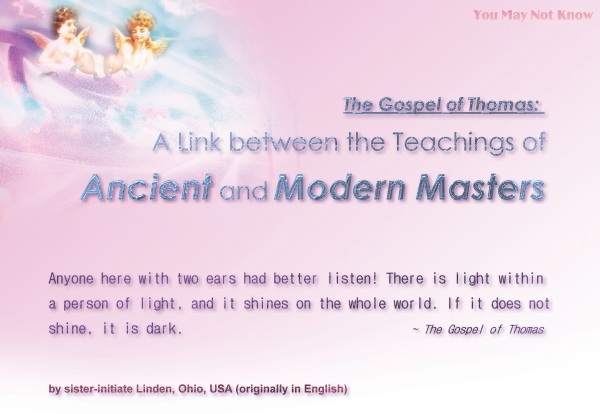
In the article “You May Not Know: The Lost Books of the Bible” from the News # 81, author James Bean begins with a quote from Supreme Master Ching Hai on the relative incompleteness of our modern day Bible: “The true Bible is locked up somewhere and we are never allowed to see it. But some of the newly-dug [texts] from ancient sites — the Bible, some parts of it have come out and some of it mentions reincarnation.”
One of these missing parts emerged from an earthen jar full of codices found by a farmer at Nag Hammadi, Egypt in 1946. Written in Coptic (a language derived from ancient Egyptian), these manuscripts date back to the 4th Century. Historians believe that monks from a nearby monastery buried the texts in the jar to save them from destruction.
After the discovery, which included the so-called Gospel of St. Thomas, reports began to circulate in the U. S. that new words of Jesus had been found, and the book was informally referred to as “The Fifth Gospel.” Although it was never added to any of the official versions of the published Bible, the importance of The Gospel of Thomas cannot be denied. It contains 114 sayings attributed to Jesus that could be as old as the material in the canonical gospels of Matthew, Mark, Luke and John. Further verifying the authenticity of this scripture was the realization that portions in the original Greek language had already been discovered at Oxyrhynchus, Egypt, in the late 1800s.
The Gospel of St. Thomas differs from the canonical gospels in making no mention of Jesus’ life, but only presents His teachings. Mr. Bean describes The Gospel of Thomas as “a collection of the spiritual sayings of Jesus on gaining enlightenment and discovering the Kingdom of God.” Some of these aphorisms parallel those found in the Bible, for example, consider the following excerpt.
“Jesus said, ‘Love your friends like your own soul, protect them like the pupil of your eye.’ And Jesus said, ‘You see the sliver in your friend’s eye, but you don’t see the timber in your own eye. When you take the timber out of your own eye, then you will see well enough to remove the sliver from your friend’s eye.’” (Translation by Stephen Patterson and Marvin Meyer)
These lines closely resemble Matthew 7: 1-5 from the canonical New Testament: “Judge not, that you may not be judged; for your own judgment will be dealt — and your own measure meted — to yourselves. And why do you look at the splinter in your brother’s eye, and not notice the beam which is in your own eye? Or how say to your brother, ‘Allow me to take the splinter out of your eye,’ while the beam is in your own eye? Hypocrite, first take the beam out of your own eye, and then you will see clearly how to remove the splinter from your brother’s eye.”
And other sayings from The Gospel of Thomas are much like those of Supreme Master Ching Hai: “His disciples said, ‘Show us the place where you are, for we must seek it.’ He said to them, ‘Anyone here with two ears had better listen! There is light within a person of light, and it shines on the whole world. If it does not shine, it is dark.’” (Translated by Stephen Patterson and Marvin Meyer)
Here the message of Jesus brings to mind part of Master’s lecture delivered in Formosa in 1992 and recently published in the News #148: “[For] we who practice the Quan Yin Method, the Light within us is infinite, and our inner peace and love are inconceivable. When we cultivate ourselves spiritually in Formosa, it not only benefits the Formosan people, but our Light permeates the whole world.”
Thus, the text provides a link between the words and ideas of ancient and modern Masters and shows the universality and timelessness of God’s message of Truth.
Moreover, this recently discovered portion of the Bible provides an added perspective to the one we get from reading “authorized” versions of the Bible. For example, in The Gospel of Thomas Jesus is revealed as a Master who taught His disciples, “We have come from the Light, from the place where the Light came into being by itself,’ and ‘If one is whole, one will be filled with Light.’ And also, ‘He who will drink from my mouth will become like me; I myself shall become that person, and the hidden things will be revealed to that person.’ Here the image of drinking from the mouth of Christ undoubtedly refers to the process of Quan Yin Initiation — contemplating the Sound, the Word or the cosmic Voice of God.
So the unearthing of scriptures such as The Gospel of Thomas helps to create a more complete sense of the depth of Jesus’ life and teachings. Such texts also convey to twenty-first century readers a clearer understanding of Jesus as a living Master, one whose message was intended to help others contact God directly through contemplation of the inner Light and Sound, just as the words of Supreme Master Ching Hai do today.
![]()
![]()
For related information, please refer to:
1. News magazine article, Issue 81,
http: //www.godsdirectcontact.us/sm21/enews/htm/081/n.html
2. Page with translations of The Gospel of Thomas, http://www.earlychristianwritings.com/thomas.html
3. Many of the other manuscripts found at the Nag Hammadi site in Egypt have also been translated.
The Gospel of Thomas is just part of this library, which is available in various English translations at http://www.gnosis.org/naghamm/nhlalpha.html